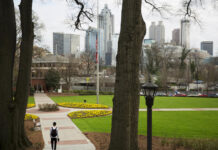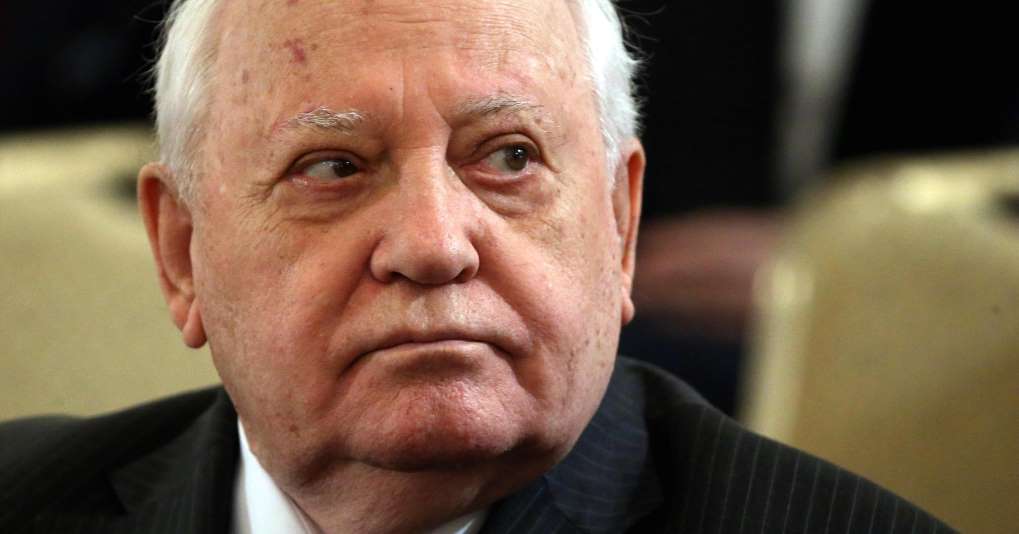March 10, 2016
KENT, Washington — Long before he ever conceived the idea to sell books on the Internet, he was obsessed with space.

During a media tour of Blue Origin, Amazon.com founder Jeff Bezos stands next to a copper exhaust nozzle to be used on a spaceship engine. (Donna Blankinship/Associated Press)
March 10, 2016
KENT, Washington — Long before he ever conceived the idea to sell books on the Internet, he was obsessed with space.

During a media tour of Blue Origin, Amazon.com founder Jeff Bezos stands next to a copper exhaust nozzle to be used on a spaceship engine. (Donna Blankinship/Associated Press)
It started at age 5, when he watched the Apollo 11 moon landing, and continued on through his Trekkie adolescence to high school, when Jeffrey P. Bezos gave his valedictory speech about space travel and reportedly told friends that the “future of mankind is not on this planet.”
The obsession continued as the bookstore idea became Amazon.com and made him one of the world’s richest men, freeing him to think seriously about his childhood obsession and to do something about it.
“I wanted to start a space company from when I was a little kid, but I never expected to have the resources to do so,” Bezos told a small group of reporters invited to tour the center Tuesday. “Then I won this lottery ticket called Amazon.com. And so when Amazon became a successful company, I realized, ‘Hey, I can actually fulfill my childhood dreams of starting a space company,’ and that’s what I did.”
His space company, Blue Origin — blue for the “pale blue dot” that is Earth; “origin” for where humanity began — is now, some 16 years after its founding, showing tangible signs of progress. For the first time, Bezos opened the doors of the company he has kept quiet for years and talked openly and at length about its vision — the day “when millions of people are living and working in space.”
Over the course of more than four free-wheeling hours, he spoke on the future of space tourism and why increased energy consumption is driving space exploration. He talked about how space will be a viable business and why Mars is for only the “very adventurous,” making Antarctica look like “a garden paradise.” And then he discussed what he called “the big inversion”— how he predicts that all heavy industry will move off Earth into space, where there are limitless resources, so that Earth could be preserved.
He made it clear that he is as serious about the future of space as he is about online retailing, if not more so. (Bezos also owns The Washington Post.)
“It’ll just be an incredibly fun, inspiring part of humanity’s future to go exploring the solar system,” he said. “Who wouldn’t want to do that? Sign me up.”
A secretive founding
Compared with Elon Musk’s SpaceX, which was founded a couple of years later, the older Blue Origin is still in its infancy. SpaceX has charged ahead, passing milestone after milestone with its Falcon 9 rocket and Dragon spacecraft, which became the first private one to visit the International Space Station. In addition to flying cargo to the station, SpaceX also has a contract to fly astronauts there by 2017, along with Boeing. It also has won the right to bid on lucrative national security launches and is competing in the commercial satellite launch business as well.
SpaceX’s success has helped touch off a renaissance in the commercial space industry — including Richard Branson’s Virgin Galactic, which, like Blue Origin, promises to take tourists to space — said Greg Autry, a professor at the University of Southern California’s Marshall School of Business.
“SpaceX has had to do the heavy lifting in getting the public and getting Congress and others to accept commercial space,” he said.

Blue Origin has moved much slower, and it has been much more secretive. In the first few years after Bezos founded the company in 2000, it was just him and a handful of employees trying to see if there was a better way to launch humans into space. But it was dedicated and exclusive — even a touch arrogant.
“You must have a genuine passion for space,” the company’s jobs page said. “Without passion, you will find what we’re trying to do much too difficult. There are much easier jobs. You must want to work in a small company. If you can happily work at a large company, you’re probably not the right person.
“Our hiring bar is unabashedly extreme. We insist on keeping our team size small (measured in the dozens), which means that each person occupying a spot must be among the most technically gifted in his or her field. We are building real hardware — not PowerPoint presentations. This must excite you. You must be a builder.”
For all the bluster, it wasn’t until last year — 15 years after it was founded — that Blue Origin had the first successful test flight of its New Shepard vehicle. Launching from the company’s site in West Texas, it reached Mach 3, or three times the speed of sound, and soared 58 miles high, near what is considered the edge of space. Then, in November, it launched again. This time, it passed the boundary of space, and it also was able to land the first stage of its rocket back on land. Last month, it launched and landed the same rocket — showing that it could be flown more than once.

The work hasn’t come cheap. Bezos declined to say how much he has invested, except to say that it is more than $500 million.
“Let’s say it’s a big number,” he told reporters.
Bezos is famous for taking the long view with his ventures, moving methodically and relentlessly toward his uncompromising vision. That was true at Amazon, and Bezos said the same philosophy applies at Blue Origin, whose Latin motto is Gradatim Ferociter — which translates loosely to “Step By Step, Ferociously.”
In addition to its logo, a feather, the company has a coat of arms. It is an involved piece of art, loaded with symbols from the Earth to the stars to the velocities needed to reach various altitudes in space. Perhaps none are more important than the pair of turtles, an homage to the winner of the race between the turtle and the hare. But there is also an hourglass symbolizing human mortality.
“Time is fleeting,” Bezos said on the tour. But, he added, “you get there faster when you take one step at a time.”
The company was quiet for so long because it hadn’t accomplished anything worth talking about, Bezos said.
But now, after spending so many years researching and testing, he said, “really exciting cool stuff that’s not just hype is coming out the other end.”
Out into the solar system
Musk’s goal is to colonize Mars, to create another place for humanity to live in case something should happen to Earth. That rationale, Bezos said, is “reasonable.”
“I think we’re very like-minded about a lot of things,” Bezos said. “We’re not twins in terms of our conceptualization of the future. . . . But there are a lot of similarities.”
They both see space as a way to further humanity, but Bezos is concerned about rising energy usage, which has been growing at 2 to 3 percent a year. At that rate, he said, over a few hundred years, “you’d have to cover the entire Earth’s surface with solar cells” to keep up with demand.
Covering the entire planet with solar cells is “not going to work,” he said. “And we only have a few hundred years to figure this out. There are radical solutions. You could try to do radical population control.”
Blue Origin rocket makes second safe landing on Earth
The rocket company created by Jeff Bezos has created a rocket that has vertically landed on Earth after flying above the Karman line twice.
But Bezos’s solution is to “spread out into the solar system” to mine the “limitless” resources in space. All heavy industry would move into space, where there would be asteroid mining, and Earth would be preserved as if it were exclusively zoned “residential and light industrial,” he said, laughing.
“Sometime in the next few hundred years,” he said, “there will be a big inversion where we will realize that we shouldn’t be doing heavy industry on Earth for two reasons: One, it’s very polluting; and two, we don’t have access to enough energy here do it. It just won’t be practical.”
Like Musk, Bezos is interested in Mars. But the planet is so forbidding, he said, it would only be for the “very hearty, very adventurous.” He added that he is interested in Mars “and everywhere else.”
In the near term, he said, space tourism is a logical first step to democratizing space, a way to practice flying over and over, a key component to the company’s goal of lowering the cost of spaceflight. Entertainment has been integral to the early development of any technology, he said, just as video games helped advance computing. On the tour, he showed off a couple of capsules under construction and the seats — similar to chaise lounges — that would be reclined by massive windows offering a view of Earth from space from pilotless rockets.

Blue Origin team members ready the New Shepard crew capsule during assembly. (Photo courtesy of Blue Origin)
The first test pilots could fly as soon as next year, Bezos said, with ticketed passengers booking space flights in 2018. While Virgin Galactic has charged as much as $250,000 a flight in SpaceShipTwo, a winged vehicle that lands on a runway, Blue Origin hasn’t yet announced its prices.
The next step is building an orbital rocket that Blue Origin calls “Very Big Brother.” It would be powered by a new engine, known as the BE-4, and fly by the end of the decade. Those projects are driving a hiring spree. The company, which now has 600 employees, plans to grow to more than 1,000 within a year.
With Amazon taking up most of his time, Bezos said he spends almost every Wednesday at Blue Origin headquarters here, just south of Seattle. A model of the Starship Enterprise from “Star Trek” greets visitors in the lobby, where there is a combination model rocket and mini lounge outfitted with comfortable couches and bookshelves filled with titles such as “From the Earth to the Moon,” and “20,000 Leagues Under the Sea.” Underneath is a fire pit, making it seem as if flames were shooting from the bottom of the rocket.
It is a quirky and detailed accoutrement, designed to make the foreign familiar.
Courtesy: Washington Post











































































































